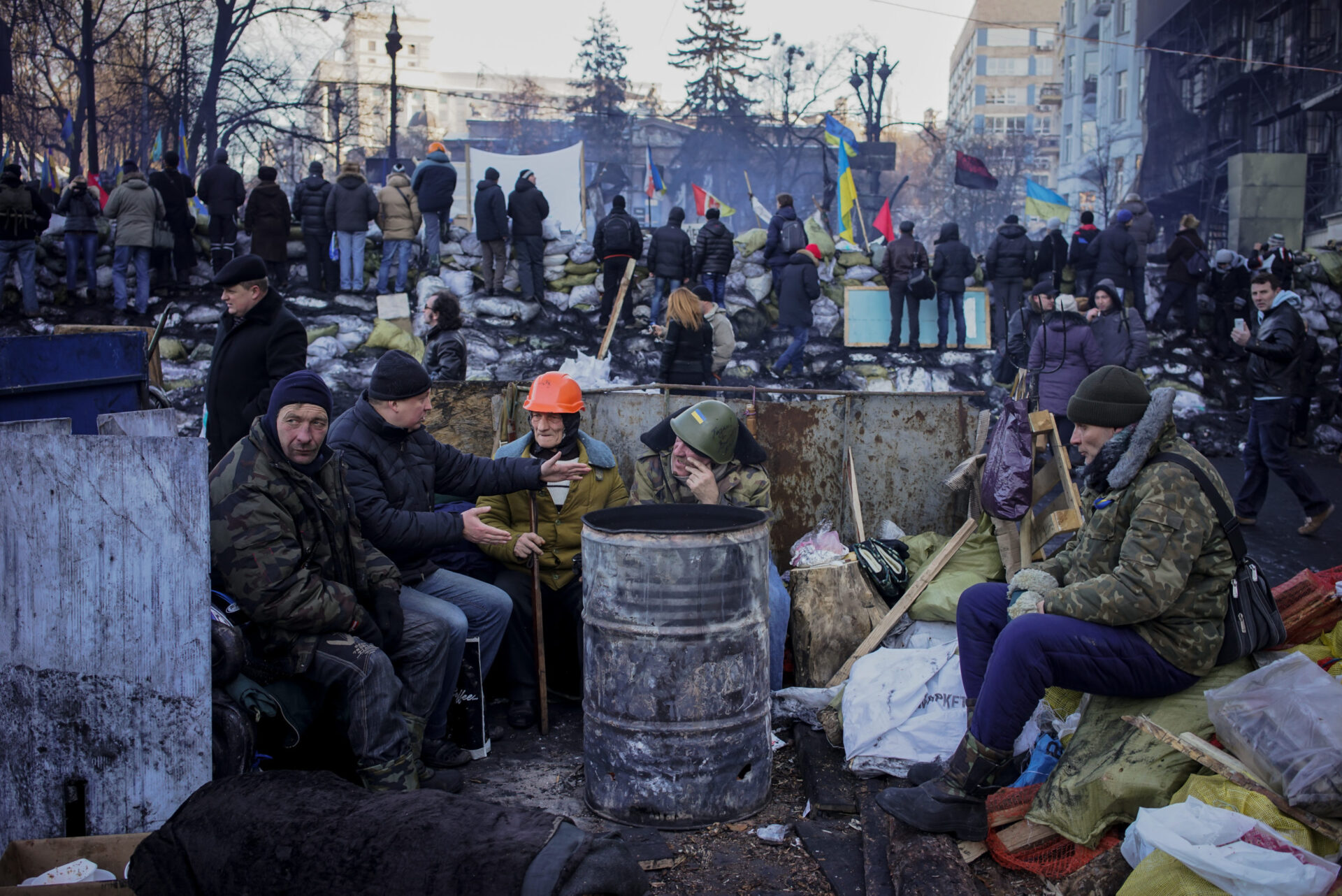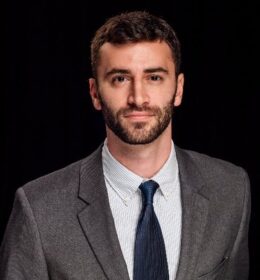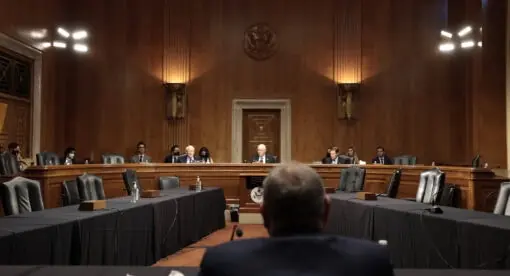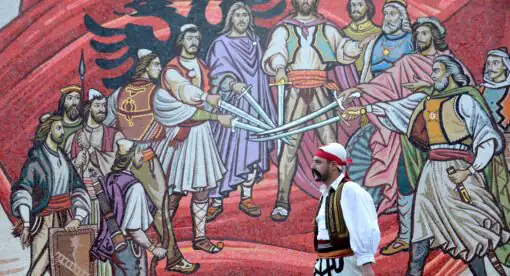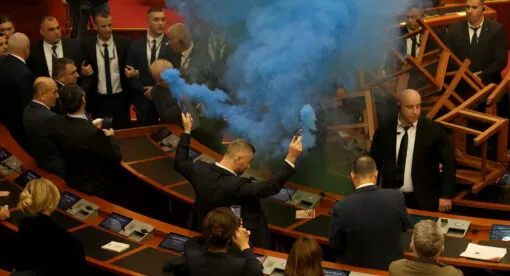A small demonstration in Kiev that expanded into a nationwide movement in 2014 offers parallels to current protests in the United States.
As the United States faces continuing protests over police brutality and social justice amidst the persistent COVID-19 pandemic, there is major uncertainty over the political effects of these demonstrations. With President Donald Trump facing a tough re-election contest in November, these protests could have significant political and geopolitical implications for the country and the world.
One case study that offers insights into the current protest movement in the United States can be found in a seemingly unlikely place: Ukraine and the EuroMaidan protests of 2013-14. From police actions providing a catalyst for large demonstrations to protests spurring broader political implications, EuroMaidan holds important lessons for U.S. policymakers to heed moving forward.
What Happened in Ukraine
In late November 2013, a small protest occurred in Maidan Nezalezhnosti, the central square of Ukraine’s capital city of Kiev. The trigger for the protest was the decision by then-Ukrainian President Viktor Yanukovych to abruptly withdraw from negotiations with the EU over a free trade and Association Agreement. Yanukovych, who hailed from the pro-Russia Donbas region of Eastern Ukraine, instead opted for closer integration with Russia. This brought a group of several dozen people, most of them students, to Maidan to demonstrate against the move and in favor of EU integration.
Ukrainian security forces cracked down on the protests with beatings and detentions, which caused the demonstrations to swell to hundreds of thousands of people by the end of the month. The protests would last for months, evolving into a fixed presence of demonstrators residing in hundreds of tents spread across Maidan and spilling over several blocks along Khreshchatyk Street, the city’s main thoroughfare. Eventually, the protesters would take over several government and administration buildings in the area and form their own autonomous zone manned by “self-defense groups” in the heart of the capital city.
The demonstrations persisted for three months and reached their climax in February 2014, when clashes between security forces and demonstrators escalated into violence, resulting in the deaths of over 100 people. Yanukovych eventually came to an agreement with the main opposition parties active in the demonstrations to diffuse tensions, but this deal was scuttled by the more radicalized segments of the protesters, who gave the president an ultimatum to flee the country or else risk his life. On Feb 22, Yanukovych fled to Russia, and an interim, EU-aligned government was installed. This was followed by snap presidential and parliamentary elections in May and October 2014, respectively, which cemented the new political reality in Ukraine.
The EuroMaidan revolution, as it came to be known, was triggered by a single event — a police crackdown on pro-EU protests — but the public unrest was a symptom of Ukraine’s deep, geographically rooted polarization between pro-Russian and pro-European political forces.
For centuries, the country had been split between various empires, most notably the Russian (and then Soviet) empire to the east and European empires like the Austro-Hungarian Empire and Polish-Lithuanian Commonwealth to the west. The result was a heterogeneous society in Ukraine, with different languages (Ukrainian and Russian), religions (Catholicism and Orthodoxy), and political orientations (Western and Eastern). But these differences were contained and rendered largely moot during the Soviet era, when the country was under the firm control of Moscow. When Ukraine gained independence in 1991 for the first time in centuries, these rifts continued to manifest in the form of new political parties centered around familiar divisions: a Western-oriented center/west and a Russian-oriented south/east. Ukraine thus saw a constant oscillation in elections between pro-Russian and pro-Western governments, with the political polarization only growing until it erupted into the EuroMaidan revolution.
Parallels to U.S. protests
More than six years later, it is the United States that is in the throes of protest over police brutality and social justice issues. To be sure, the circumstances and context of the current demonstrations are much different than they were in Ukraine. The United States is a consolidated democracy, whereas Ukraine was a relatively nascent one where corruption levels across most institutions have been high. The United States is also not as vulnerable to external political influence as Ukraine was (though social media manipulation, cyberattacks, and the coronavirus pandemic do prove the country’s vulnerability to external factors). Nevertheless, there are important parallels from the Ukrainian events that could offer lessons and perhaps even give some indications of what to expect moving forward in the United States.
As with Ukraine, the current U.S. protests had a specific trigger — the May 25 killing of George Floyd by Minneapolis police — that started a wave of demonstrations in Minneapolis that spread across the country, activating a much larger participation of protesters than the initial event. As demonstrations have continued, the message of the protests has morphed beyond outrage at Floyd’s killing and taken on a broader message against the corruption of the police as an institution, as well as against the policies and leadership of the U.S. government.
Also as with Ukraine, there were underlying tensions and polarization that long predated these protests. The United States has a history of racial disparity going back to its foundation, just as Ukraine’s polarization between Russian-oriented and Western-oriented groups formed a key part of its historical makeup. In both cases, historical monuments and statues served as important symbols: Just as Confederate statues have been targeted and toppled by U.S. protesters, pro-Western groups targeted and toppled statues of Soviet leader Vladimir Lenin and other forms of Soviet/Communist symbols throughout Ukraine.
Another important parallel is the role of radicalized forces within the protest movement. While demonstrations have been largely peaceful in the United States just as they were initially in Ukraine, they have been influenced and/or exploited by more radicalized actors or groups. This can be seen in the rioting and looting in several American cities in the immediate wake of Floyd’s killing and the establishment of the Capital Hill Organized Protest zone in Seattle, just as radicalized groups in Ukraine like Right Sector ended up being on the frontlines of clashes with police on Maidan. In both cases, such radicalized forces have been small in relative size but powerful in overall effect.
Lessons from Maidan
An important lesson from Ukraine for the United States is that legitimacy of institutions matters. In the case of Ukraine, Yanukovych and his ruling Party of Regions had always been controversial among the pro-Western electorate, as were the security forces that backed them. In the initial police crackdown against protesters, both institutions lost their legitimacy from a decisive part of the electorate, broadening out to more than just the core pro-Western elements to a significant chunk of the public at large. The result was the forced departure of the president, the dissolution of the ruling party (later to be regrouped in a different form), and the purging of Yanukovych loyalists from within the police and judicial structures.
In the case of the United States, the legitimacy of the police as an institution — long a subject of protest by Black Americans — is being increasingly questioned by a broader part of the electorate, especially among younger white people. To this group, the idea that brutal police killings are perpetrated by just a few “bad apples” amongst an otherwise effective system is decreasingly holding sway. And whether it is on the streets currently or at the ballot box in November, this loss of legitimacy can have substantial impact.
Another key lesson is that in order for any heterogeneous or multicultural society to function effectively, the institutions must be stronger than — or rather separate from — their ethnic/cultural divisions. In the case of Ukraine, it was the Berkut security forces, many members of which hailed from eastern and southern Ukrainian regions, that displayed regional/political loyalties at the expense of national unity. In the case of the United States, it is a police force that is increasingly seen as systematically biased against Black Americans and above the rule of law. It’s also pertinent that the forces used to quell U.S. protests are actually a hodgepodge of armed personnel from a variety of different local, state, and federal agencies, further bringing into question their legitimacy.
Unpopular police crackdowns also can create larger political problems, driving more people to operate outside of the system. In “Political Order in Changing Societies,” Samuel Huntington wrote, “Violence is more often a symbolic gesture of protest which goes unrequited and is not designed to be requited. It is a symptom of a more extreme alienation. He who corrupts a system’s police officers is more likely to identify with the system than he who storms the system’s police stations.” If the situation in the United States lingers on long enough without decisive policy changes, radical forces can become increasingly powerful. As in Ukraine, any reforms or agreements reached between the government and more moderate protesters/opposition groups in such an environment risks coming too little, too late. While the United States is extremely unlikely to descend into the type of separatism and military conflict seen in Ukraine, the conditions for greater political and security instability are nevertheless there.
Looking ahead
As the United States is still in the thick of the protest movement, it is perhaps instructive to look at how the situation in Ukraine ultimately played out in order to identify the risks and opportunities for the U.S. government moving forward.
The EuroMaidan uprising caused a chain reaction in which pro-Russian forces directly or indirectly aided by Russia responded with a counter-Maidan movement throughout the country. These movements were strongest in Crimea — which was quickly annexed by Russia — and in Eastern Ukraine, which began an armed uprising of its own and became a de facto separatist statelet supported militarily and economically by Russia. These events spurred a broader standoff and competition between Russia and the West, which spread beyond Eastern Europe and into Russian military involvement and security deployments in places like Syria and Venezuela in order to back anti-U.S. regimes. The consequences were both long-lasting (these conflicts continue to this day) and far-reaching.
Thus, the longer the protests continue in the United States without meaningful political change, the greater the political polarization and the more unpredictable the consequences can be. This is especially the case as rhetoric between opposing sides heats up. In Ukraine, it was common for the Yanukovych government and many people in Crimea and Donbas to call the protesters in Kiev “terrorists” and “fascists,” while the other side was blamed for being “pro-Russian stooges.” In the United States, protesters have been labeled by Trump as “anarchists” and “leftist radicals,” while anyone supporting law and order quickly gets swept into the pro-Trump camp. Such rhetoric only serves to inflame the divides, narrow the room for constructive dialogue, and foster a more intense collision between the groups.
If the situation in the United States lingers long enough without decisive policy changes that have social and political buy-in, the consequences could be deep and wide. Real policy changes are necessary to avoid further escalations, and a constructive dialogue between protesters, police, and the government is perhaps as important now as ever before.
Eugene Chausovsky is a Nonresident Fellow with the Newlines Institute. Previously, he served as Senior Eurasia Analyst at Stratfor for 10 years. His work focuses on political, economic, and security issues pertaining to the former Soviet Union, Europe, and Latin America. He Tweets at @EugeneChausovsk.
The views expressed in this article are those of the author and not an official policy or position of the Newlines Institute.

